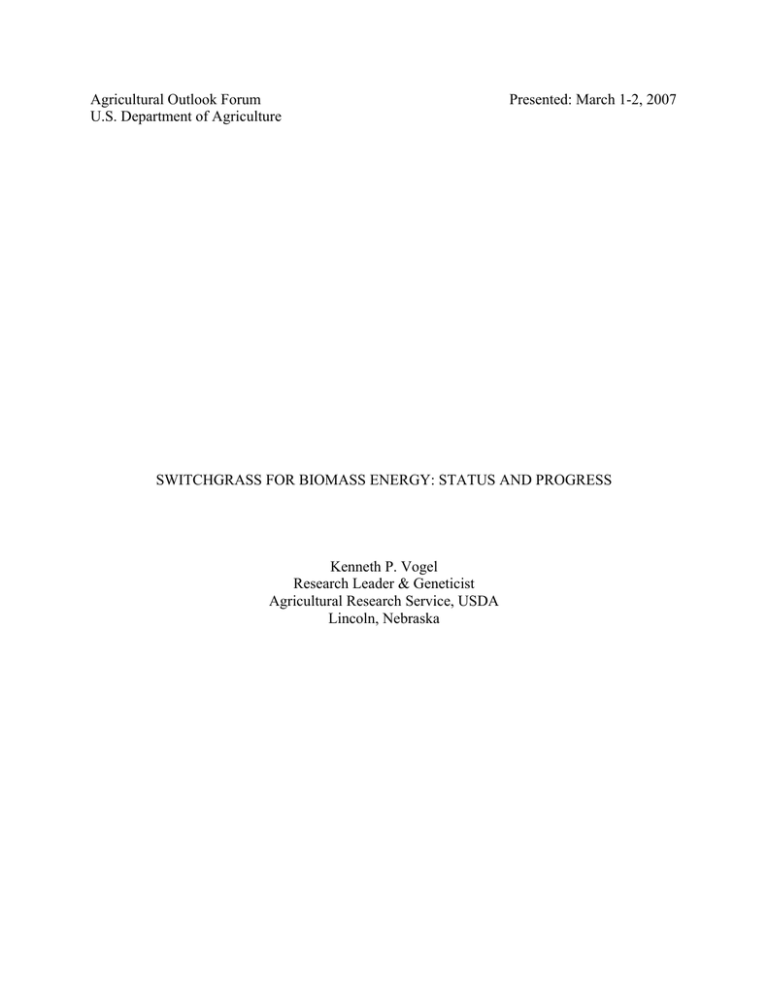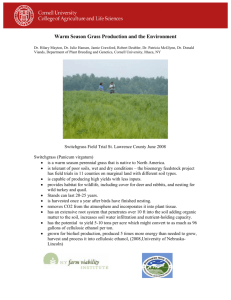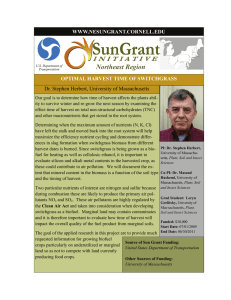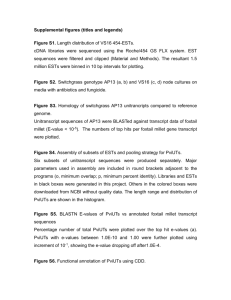Document 11629796
advertisement

Agricultural Outlook Forum U.S. Department of Agriculture Presented: March 1-2, 2007 SWITCHGRASS FOR BIOMASS ENERGY: STATUS AND PROGRESS Kenneth P. Vogel Research Leader & Geneticist Agricultural Research Service, USDA Lincoln, Nebraska SWITCHGRASS FOR BIOMASS ENERGY: STATUS AND PROGRESS Kenneth P. Vogel Research Leader & Geneticist Agricultural Research Service, USDA Lincoln, Nebraska Presented Thursday, March 1, 2007 USDA-ARS Forage & Biomass Research Project- Lincoln,NE • Switchgrass research 1930’s to present. • Switchgrass domestication – breeding and management. • Prior to mid-1990’s, use by livestock had been emphasized. • 1990 - began work to develop switchgrass into biofuels crop (DOE cooperative research) Northern Plains Switchgrass Field Scale Production & Economic Trials 15”-17” Annual Precipitation 2000-2006 On-Farm Production Trials:15-20 acre fields 31”-33” Annual Precipitation Energy Production in the Great Plains – On farm economic study. • • • • • Field shown at left had a five year cumulative average cost of $30/U.S. ton switchgrass biomass including land costs. Average costs for 10 farms was $49/ton; experienced farmer’s costs were $36/ton. Economic analyses in journal review (UNL Ag Economist) Data from trials being used for net energy balance analysis. Soils sampled before & after trials – C sequestraion research (ARS Lincoln & Mandan, ND.) Switchgrass field in NE South Dakota in 2005. Yields averaged 4 tons/acre. Take Home Lessons • Economic production efficiency can be improved via research and producer training. • Improved high yielding cultivars/hybrids with improved conversion efficiency are needed. • Additional agronomic research on fertility, establishment, seed quality, & other factors. • Feedstock harvesting and storage research needed. • Adaptation and production trials in other potential biomass production areas are needed. Switchgrass biomass energy Current Goals & Research • Goals • Full establishment in 1 year with 50% yield. • Be at full production second year. • Goal of 10T/A (Midwest); improved ethanol yield/ton. • Fully documented environmental benefits • Tools and Products • Weed control, no-till planting, seed quality. • Breeding - Biomass specific cultivars & F1 hybrids, improved conversion • Molecular biology, cell wall modification & seed quality. • Environ. studies/ C sequestration. Establishment & Seed Quality • Establishment weed control with improved herbicides Biochemical & molecular studies on mechanisms of switchgrass seed dormancy and germination. . Different seed quality tests Fluorescence microscopy of switchgrass seeds incubated on FDA for 2 days Improved seed quality & seed quality tests (Sarath et al., 2006. Planta 223:1154-1164) Breeding improved grasses for biomass and grassland production systems: multi-step process. Germplasm evaluation & Selection nurseries. Polycross Hybridization Regional yield Regional small plot trials tests. Grazing trials to document economic value Breeding Progress for Conventional Switchgrass Cultivars Yield Trial Mead, NE 2003-2005 Cultivar Year released Trailblazer 1984 IVDMD Biomass yield (%) (tons/acre) (mature) 6.3 52.5 Shawnee 1995 6.5 54.8 7.4 53.8 7.0 55.2 NE 2000C1 In seed increase NE Late In seed YD C4 increase Improve biomass yields – hybrid cultivars Strain Kanlow & Summer F1’s Kanlow Summer Yield tons/acre 9.4 7.1 6.1 • Improved hybrid cultivars with modified cell walls could improve ethanol yields & reduce costs. Biorefineries and Biomass Feedstock Quality (source: Nebraska Ethanol Board) Switchgrass genetic variation in stem lignin (STLIG) & digestibility (STDMD) Regression of STLIG vs STDMD Population: 3 cycles for High DMD STLIG (g/kg) For 1550 Each graph point is a two year mean of a switchgrass genotype 80 75 70 65 60 55 50 45 40 r²= 0.766 F=638.35 df=195 400 450 500 550 600 STDMD (g/kg) Regression of STLIG vs STDMD for 836 Population: 1 cycle for low DMD STLIG (g/kg) 90 r²= 0.736 F= 547.5 df=196 80 70 60 50 40 300 400 500 STDMD (g/kg) 600 Genetic effects on lignin, anatomy & ethanol yield from switchgrass cellulose Thick, lignified layer ↓ Mean Ethanol Yield mg/g 80 Stem Lignin 63.2 g/kg Eth an o l yield (m g /g 78 76 74 72 70 68 66 64 C-1 Hi Lig Stem Lignin 50.7 g/kg C-1 Lo Lig C+3 Hi Lig Population C+3 Lo Lig Modification of switchgrass cell walls can have adversely fitness effect – maintaining fitness must be part of improvement strategy. Results of multi-cycle selection for increased forage digestibility without selection for yield or fitness. Means from multi-year trials at Mead, NE, Ames, IA, and Madison, WI. Cycle 3 half-sib family nursery at Mead, NE showing differential winter kill among families. Carbon sequestration Study- Corn vs Switchgrass, Mead, NE • Quantify carbon sequestration on cropland converted to switchgrass. • Compare to no-till corn. • Ten year experiment in eastern NE established in 1998. • In 2000, plots split and stover removed (50%) on split half of corn plots. • Cooperative ARS-Ft. Collins (R. Follett) & NRCS National Soils Lab ARS Switchgrass and other Herbaceous Bioenergy Crop Research St. Paul, MN Mandan, ND Management Alfalfa Breeding Molecular Genetics Quality Management Madison, WI Switchgrass Other Grasses Breeding Management Corvallis, OR Gasification Other Grasses College Park, PA Switchgrass Management Albany, CA Switchgrass Molecular genetics ERRC, PA Lincoln, NE Gasification Switchgrass Other Grasses Breeding Molecular biology Management Economics Harvest & Storage Quality Athens, GA Spectroscopy Quality Tifton, GA Conversion Peoria, IL Switchgrass Alfalfa Fermentation Conversion Other grasses Breeding Management Bottom Line • Switchgrass is an economically feasible biomass energy crop for use on marginal cropland. • Improvements in genetics and agronomics will improve: – – – – biomass yields biomass quality conversion ethanol yield per acre




